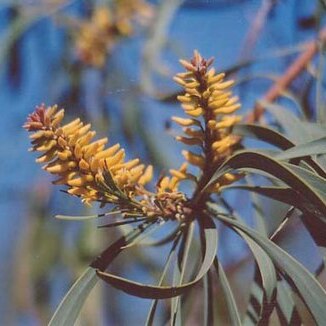A slender shrub or tree. It grows 3-9 m high. It is often a shrub 2-3 m high. The small branches often hang down. The new shoots have fine hairs. The leaves are alternate and smooth. They are slightly leathery. They vary in shape and size. Leaves can be straight or curved. The blade is 10-20 cm long by 0.5-2.5 cm wide. They are dull green and have a distinct midrib. The flowers are yellow and like tubes. They are 1-1.5 cm long. They occur singly in the axils of the upper leaves. They can also be in groups along stalks. The fruit is smooth and oval. It has a hard stone inside. The fruit are 1.5-2 cm long by 0.8-1 cm wide. They are greenish-yellow when ripe. They contain a single seed. The fruit are edible.


